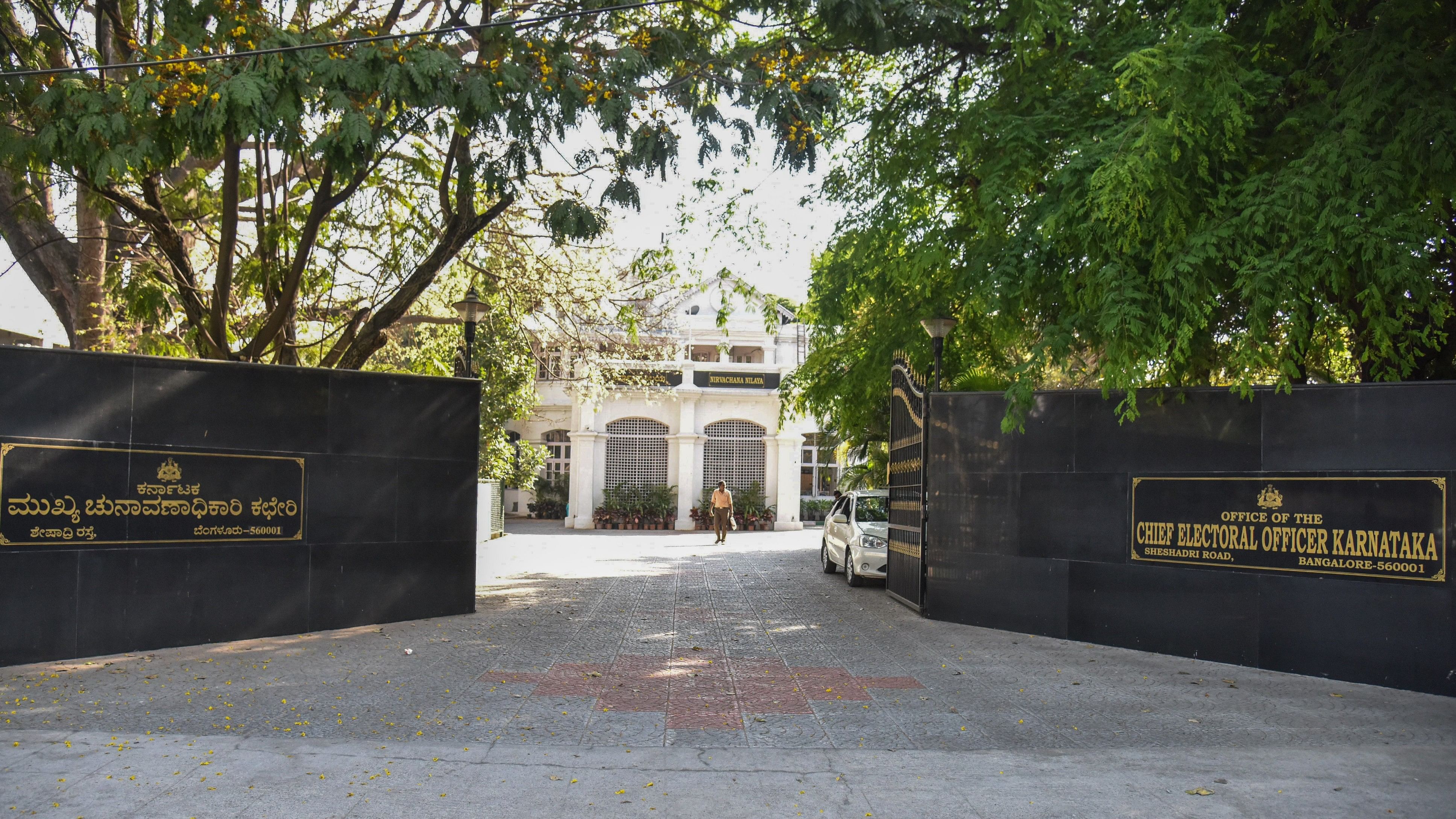
The office of Karnataka's Chief Electoral Officer in Bengaluru.
Credit: DH Photo/ S K Dinesh
For most of the year, the Nirvachana Nilaya on Seshadri Road in Bengaluru remains quiet and unnoticed. But ever since the polling season set in, the place has been buzzing. Men spill out of white cars and stride in purposefully, while other men hurry out looking equally harried.
The pretty, white heritage building in front bears a sign saying ‘Nirvachana Nilaya’ in Kannada and English. In actuality though, the comings and goings are centred around the brand new building at the back of the compound. That is where the heart of the election machinery lies: The Office of the Chief Electoral Officer for Karnataka.
The heritage building now houses a Social Media Monitoring Cell and a few other small sections of the vast electoral establishment.
Turn back the clock to 1900 and instead of security staff and election officers, you would have seen children peeping out of the windows, and suited and booted professors working at their desks. The bungalow was then called Central College House, and it served as the quarters of the principals of Central College.
First residents
We do not know when exactly the house was built, but we do know that the celebrated John Cook and his family were its first occupants. Cook took over as principal of Central College in 1882. He is sometimes referred to as the ‘maker of Central College’, for it was under him that the college expanded considerably and established a reputation for academic rigour. Cook was a polymath with a particular interest in the natural sciences, especially physics, and he built strong departments for the teaching of physics and mathematics, making Central College the premier institution in south India for science. He worked ceaselessly to establish facilities he considered absolutely necessary for a college, including a library, reading room and student hostels. Cook also had a passion for meteorology and persuaded the Mysore government to establish an observatory in the college premises.
Cook’s family had a particularly long tenure at Central College House. His daughter Annie married a professor of English, John Guthrie Tait, who became principal after Cook retired in 1908. Tait’s three children all grew up in Central College House. Another worthy who occupied Central College House was E P Metcalfe, who was principal from 1917-29 and was later Vice Chancellor of Mysore University.
From the late 1940s, principals of Central College no longer stayed at Central College House. Instead, the bungalow was converted into a hostel for students of Maharani College. Sometime later, the bungalow became the Office of the Deputy Director of Collegiate Education.
In 2011-12, the erstwhile Central College House’s long association with education ended when the Department of Collegiate Education moved out, and the building took on its present avatar as the nerve centre of the electoral apparatus in the state.
Striking asymmetry
Through all these changes, the bungalow appears largely unaltered. The most striking thing about it is its asymmetry. There is an entrance porch with two large flat arches covered with a trellis. But your eye is drawn to the curving profile on one side of the ground floor, to the decorative gable roof on the first floor, and then further up to another small curved portion above it.
As you step in, the wraparound verandah curves off sharply to your left. A small front room is dominated by a polished wooden staircase which hugs the wall as it curves upwards into the small hall on the first floor and then continues into the room above that. Large flat-arch doorways with fanlights lead into rooms to the left and right of a passage. The flooring of decorative clay tiles has remained intact after all these years.
It was not difficult to imagine the house as it might have been when it was the principal’s quarters. Children would have clattered up and down the wooden staircase. Instead of the low murmur of office noise, I could picture a time when people like Sampath Iyengar, C R Narayan Rao or Dewan Mirza Ismail sat here on sofas and discussed geology or zoology or other matters with the principal. In place of the bare walls, I saw the framed pictures that once adorned the walls: Cook wrote a short report in the Amrita Bazar Patrika about how the pictures moved in a 1904 earthquake!
The city outside Central College House has transmogrified. Yet, the house itself remains a strong reminder of the glory days of Central College, an early step in Bengaluru’s metamorphosis into a knowledge capital.
(The writer is the author of ‘Discovering Bengaluru’ and the Convenor of INTACH Bengaluru Chapter.)